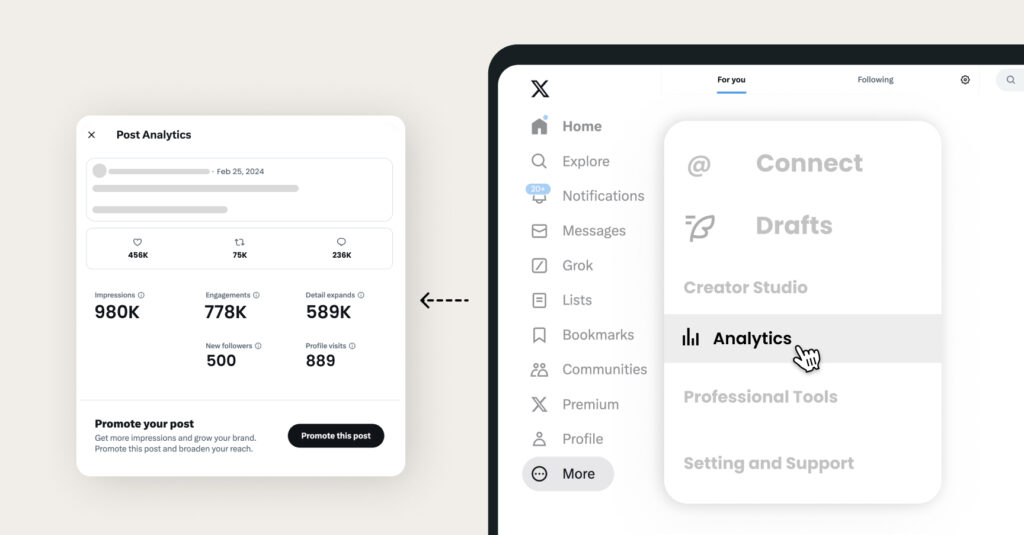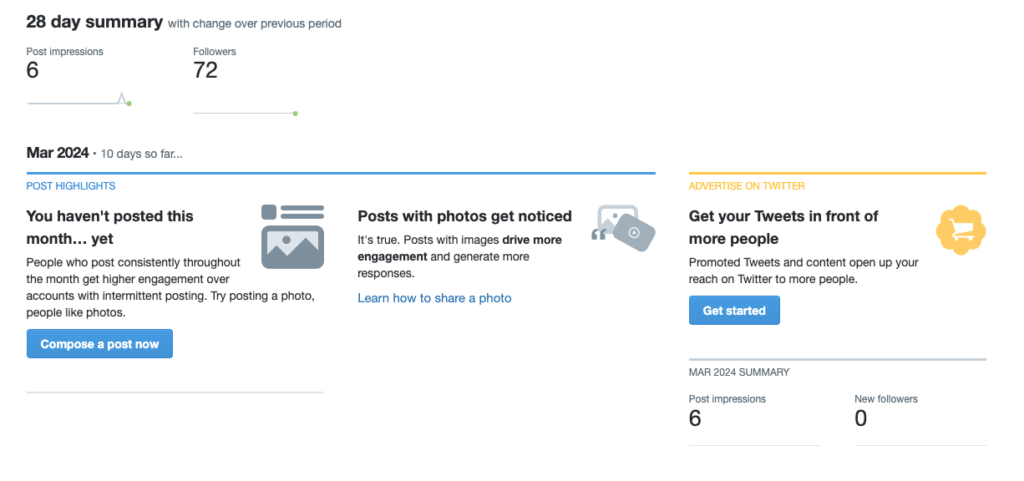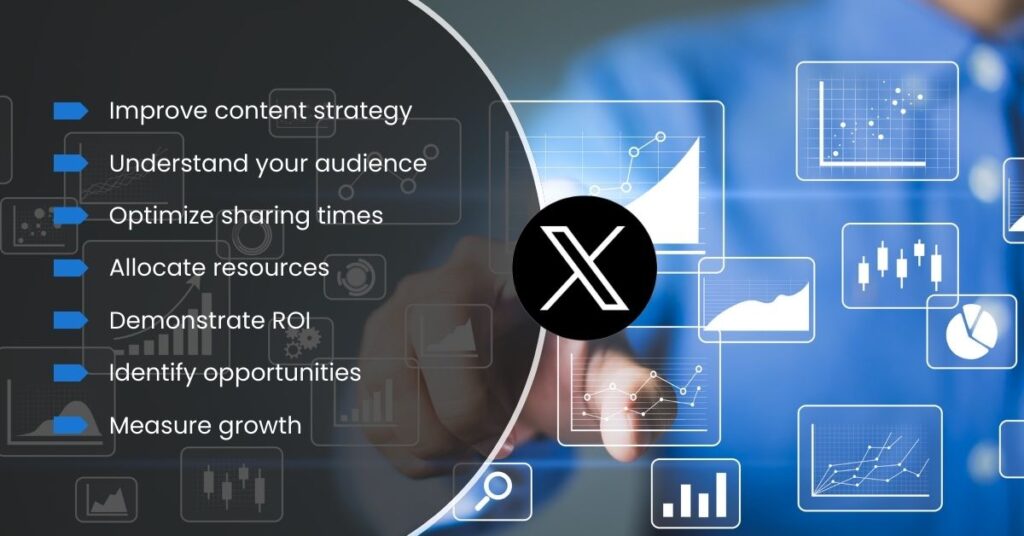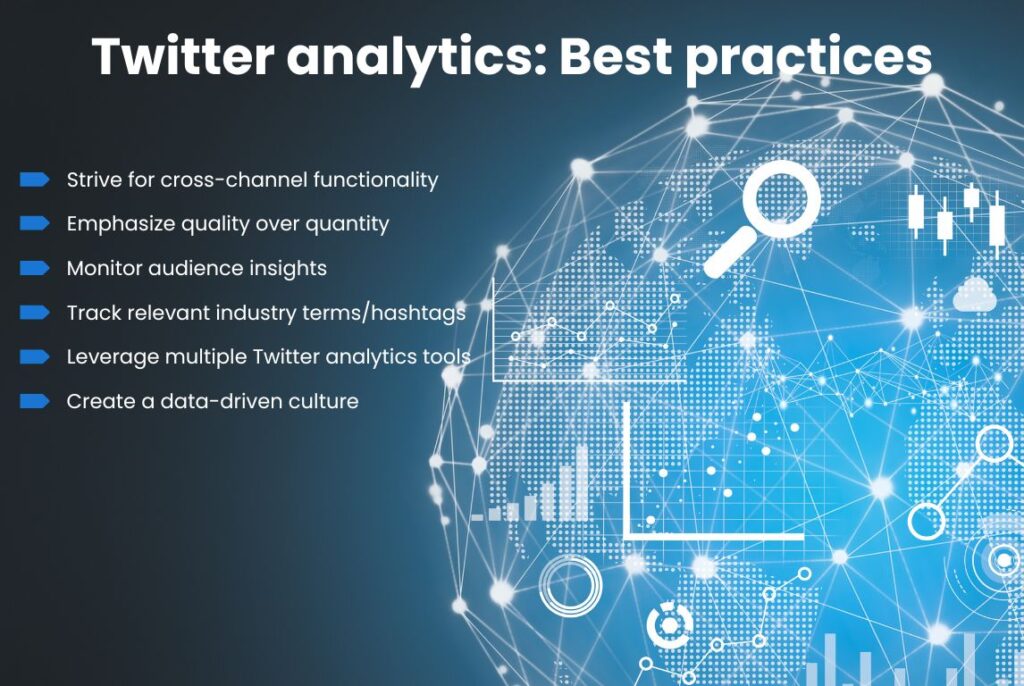

In 2023, Twitter rebranded as “X” as part of Elon Musk’s vision to transform the platform into a super app for communications, media, and finance. While the name changed, X continues to offer powerful social media analytics for brands, creators, and marketers.
Whether you default to Twitter or the new X moniker, the platform’s built-in analytics tool remains invaluable for measuring and optimizing your social media strategy. Having a data-driven pulse on your audience’s behaviors, content performance, trends, and engagement empowers you to craft more effective tweets, campaigns, and community management efforts.
In this definitive guide to Twitter analytics, we’ll cover everything from accessing your analytics dashboard and understanding the metrics to leveraging advanced metrics and third-party tools.
X analytics, previously known as Twitter analytics, is a free tool provided by the platform to track and measure the performance of your tweets, followers, and overall Twitter presence. This native analytics solution gives you transparent access to a wealth of data and metrics directly from Twitter itself.
With Twitter analytics, you can:
Overall, Twitter analytics provides a comprehensive look into what’s resonating with your audience so you can better tailor your content strategy, adjust campaigns as needed, understand emerging trends, and make data-driven improvements over time.

Accessing Twitter analytics on the X platform is simple if you have access to the analytics dashboard. Here’s how to find and view your Twitter analytics:
If you don’t see the “Analytics” option, it may be because your account hasn’t been authorized or enabled to access analytics yet. Some types of accounts, like staff accounts for larger brands or new accounts, may need to request access.
While anyone can view Twitter analytics for public accounts, it’s primarily a tool for social media managers, marketers, content creators, influencers, public figures, brands, publishers, and anyone responsible for managing a professional presence on X.
X analytics provides essential data for optimizing social media performance, understanding your audience, tracking ROI for social media campaigns, and growing an engaged community. It’s an indispensable resource if you leverage X for:
Even if you’re just a casual user, Twitter analytics can lend insights about what type of content performs well, which hashtags to use, ideal tweeting frequency, and audience demographics. However, individual users may find more value in third-party Twitter analytics tools focused on more granular metrics and reporting.
Using Twitter Analytics to measure your results and extract insights offers numerous benefits, including:

Now that you understand what Twitter analytics is and why they are valuable, let’s dive into how to best leverage this powerful tool.
While the Twitter analytics dashboard contains a wealth of data points, some metrics are more critical than others for measuring your overall performance and prioritizing optimization efforts. Here are some of the top Twitter metrics to monitor and understand:
Simply having access to all of these metrics isn’t enough — you need to know how to analyze the data in a way that produces actionable insights. Here are some tips for making the most out of Twitter analytics:
→ Birdeye’s AI-powered platform allows you to monitor customer sentiment so you can understand how customers feel about your brand.
One of the primary reasons to leverage Twitter analytics is to continuously optimize your tweeting strategy for maximum engagement. To do this, you need to carefully study the attributes of your top-performing tweets each month to determine what’s resonating best.
Pay close attention to patterns around:
By understanding and optimizing these attributes across your top tweets, you can produce more engaging content that your audience will be more likely to interact with—leading to increased reach through impressions and engagement.
To maximize the value you extract from Twitter analytics, keep these best practices in mind as you measure, analyze, and refine your X strategy:

Make sure you’re activating and optimizing consistently across all of your primary channels, like email marketing, website content, ads, and organic social, to present a unified brand experience. Align your voice, creative, and key messaging pillars across channels based on cross-channel analytics insights.
Rather than simply increasing your tweet output for the sake of volume, focus your analytics efforts on identifying the types of tweets and strategies that drive maximum engagement per post. Publishing fewer but higher-quality, more engaging tweets will produce better results.
Regularly review the audience insights report within Twitter Analytics to stay current on your followers’ top interests, demographics, locations, etc. As this evolves, refine your content strategy and targeting to remain aligned with your ideal audience.
Don’t limit yourself to campaign hashtags and brand mentions alone. Follow Analytics for relevant industry keywords, competitor brand names, trending topics, events, and other areas of interest for your business. This helps identify new opportunities and stay on top of what’s relevant to your audience.
Twitter’s native analytics tool has limitations in terms of data granularity, historical lookback windows, and reporting functionality. Consider supplementing it with third-party X analytics solutions that provide enhanced measurement, customization, team collaboration, and insights pulling in data from other channels.
Make sure everyone involved in your Twitter strategy—from social media and content teams to marketing, sales, customer service, and executive leadership—has visibility into performance metrics. Foster a collaborative, data-driven culture for continuous optimization.
Want to see the impact of Birdeye on your business? Watch the Free Demo Now.
Twitter hashtags are a critical piece of any successful social media strategy and campaign. The real-time nature of Twitter makes it a prime channel for tapping into trending conversations and increasing the visibility of your own branded hashtags.
By tracking hashtag metrics and performance, you can amplify successful hashtags, optimize their usage in your tweets and campaigns, discover new opportunities with emerging hashtags, and demonstrate ROI for any hashtag-driven campaigns.
So, what exactly should you measure when analyzing how your hashtags are performing on Twitter? Some of the top hashtag metrics and dimensions to track include:
Analyzing these hashtag metrics over time and across any specific campaigns can reveal:
Common ways to measure and visualize Twitter hashtag performance include:
There’s no one-size-fits-all best solution, as each brand and campaign will have different requirements for granularity, historical lookback periods, visualizations, and integrations with other data sources.
To access your Twitter analytics, first, make sure you’re logged into your Twitter account. Click on “More” from the navigation menu on the left-hand side of your screen, then select “Analytics” from the menu. This action will direct you to your analytics dashboard, where you can view detailed statistics about your tweets’ performance, audience demographics, and more.
Is Twitter analytics free?Yes, Twitter analytics is available at no cost for all Twitter users. This feature provides valuable insights into your tweet performance, follower growth, and engagement rates, enabling you to optimize your Twitter strategy without a financial investment.
Can you see someone else’s Twitter analytics?No, Twitter does not allow users to access the analytics of other accounts. Analytics are private and designed to offer individual users or account managers insights into their own account’s performance, including engagement rates, follower demographics, and content reach.
How accurate is Twitter analytics?Twitter analytics is highly accurate as it leverages data collected directly from Twitter’s servers. It offers a reliable measure of your account’s engagement, reach, and growth metrics. However, like any analytics tool, the interpretation of this data and its application to your strategy can influence the outcomes you achieve.
While Twitter’s native analytics provides a solid foundation, Birdeye Social takes your measurement capabilities to the next level.
With Birdeye Social, you can track Twitter alongside Facebook, Instagram, LinkedIn, and other networks to truly understand your holistic social media performance. Robust visualizations and reporting make it easy to analyze metrics like:
Rather than jumping between multiple siloed tools, Birdeye provides a centralized command center to visualize your Twitter analytics alongside other key customer experience data like reviews, surveys, ticketing, and more. This unified view enables you to optimize your social media strategy holistically while tying it back to real business outcomes.
The best part? All of this powerful social analytics functionality is just one piece of Birdeye’s full-suite, all-in-one experience marketing platform. From review management to webchat, appointments, and listings management, Birdeye helps you create connected customer experiences across every digital touchpoint.
Ready to see what all the hype is about? Watch a demo today to get started.

Birdeye's Staff Writers are dedicated to delivering insightful content on reputation management, customer engagement, and digital marketing trends. They turn complex digital marketing concepts into digestible, actionable content and help businesses leverage Birdeye's all-in-one platform for growth and success.